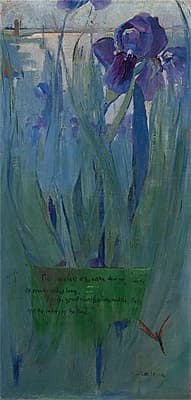
Sydney
LONG
Australia
1871
–
London
1955
England, Europe 1910-21; Australia 1921- 22; England 1922-25; Australia 1925-52; England from 1952
39.7 (h) x 19.2 (w) cm
signed ‘ SID LONG’ lower right Art Gallery of South Australia, Adelaide, M.J.M. Carter AO Collection 2006
‘Beautiful lily, dwelling by still rivers,/ Or solitary mere,/ Or where the sluggish meadow-brook delivers/ Its waters to the weir’, wrote the American poet Henry Wadsworth Longfellow in 'Flower-de-Luce' (1867).
Long inscribed his painting with the second verse of this poem: ‘Thou laughest at the mill the whirr and worry/ Of spindle and of loom,/ And the great wheel that toils amid the flurry/ And the rushing of the flume.’ In the third verse, Longfellow continued: ‘Born in the purple, born to joy and pleasance,/ Thou dost not toil nor spin,/ But makest glad and radiant with thy presence/ The meadow and the lin.’
‘Fleur de luce’ is an archaic name for the iris, a common garden plant. In painting this small oil, Long may have been motivated to express his emotional response, his feeling of joy and delight in viewing the flower, and in observing the beauty of nature around him.
Long also included irises in his illustration for D.H. Souter’s article ‘From a painter’s point of view’ in the Australian Magazine (30 March 1899).
Formerly known as Landscape with irises, this painting isnow believed to be Fleur de luce, which was first exhibited in the 1897 ‘Society of Artists exhibition’ (36).
‘Beautiful lily, dwelling by still rivers,/ Or solitary mere,/ Or where the sluggish meadow-brook delivers/ Its waters to the weir’, wrote the American poet Henry Wadsworth Longfellow in 'Flower-de-Luce' (1867).
Long inscribed his painting with the second verse of this poem: ‘Thou laughest at the mill the whirr and worry/ Of spindle and of loom,/ And the great wheel that toils amid the flurry/ And the rushing of the flume.’ In the third verse, Longfellow continued: ‘Born in the purple, born to joy and pleasance,/ Thou dost not toil nor spin,/ But makest glad and radiant with thy presence/ The meadow and the lin.’
‘Fleur de luce’ is an archaic name for the iris, a common garden plant. In painting this small oil, Long may have been motivated to express his emotional response, his feeling of joy and delight in viewing the flower, and in observing the beauty of nature around him.
Long also included irises in his illustration for D.H. Souter’s article ‘From a painter’s point of view’ in the Australian Magazine (30 March 1899).
Formerly known as Landscape with irises, this painting isnow believed to be Fleur de luce, which was first exhibited in the 1897 ‘Society of Artists exhibition’ (36).
‘Beautiful lily, dwelling by still rivers,/ Or solitary mere,/ Or where the sluggish meadow-brook delivers/ Its waters to the weir’, wrote the American poet Henry Wadsworth Longfellow in 'Flower-de-Luce' (1867).
Long inscribed his painting with the second verse of this poem: ‘Thou laughest at the mill the whirr and worry/ Of spindle and of loom,/ And the great wheel that toils amid the flurry/ And the rushing of the flume.’ In the third verse, Longfellow continued: ‘Born in the purple, born to joy and pleasance,/ Thou dost not toil nor spin,/ But makest glad and radiant with thy presence/ The meadow and the lin.’
‘Fleur de luce’ is an archaic name for the iris, a common garden plant. In painting this small oil, Long may have been motivated to express his emotional response, his feeling of joy and delight in viewing the flower, and in observing the beauty of nature around him.
Long also included irises in his illustration for D.H. Souter’s article ‘From a painter’s point of view’ in the Australian Magazine (30 March 1899).
Formerly known as Landscape with irises, this painting isnow believed to be Fleur de luce, which was first exhibited in the 1897 ‘Society of Artists exhibition’ (36).
